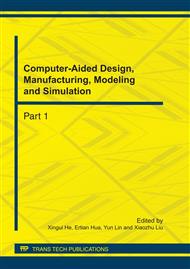[1]
C.Y. Lee, J.Y.T. Leung and G. Yu, Two machine scheduling under disruption with transportation considerations, Journal of Scheduling, vol. 9, pp.35-48 (2006).
DOI: 10.1007/s10951-006-5592-7
Google Scholar
[2]
X.T. Qi, J.F. Bard, and G. Yu, Disruption management for machine scheduling: The case of SPT schedules, vol. 103, pp.166-184 (2006).
DOI: 10.1016/j.ijpe.2005.05.021
Google Scholar
[3]
S. Albers, G. Schmidt, Scheduling with unexpected machine breakdowns, Discrete Applied Mathematics, vol. 110, pp.85-99 (2001).
DOI: 10.1016/s0166-218x(00)00266-3
Google Scholar
[4]
G. Schmidt, Scheduling on semi-identical processors, Mathematical Methods of Operations Research, vol. 28, pp.153-162 (1984).
DOI: 10.1007/bf01920917
Google Scholar
[5]
S.W. Wu, R.H. Storer, and P.C. Chang, One-machine rescheduling heuristics with efficiency and stability as criteria, Computers & Operations Research, vol. 20, pp.1-14 (1993).
DOI: 10.1016/0305-0548(93)90091-v
Google Scholar
[6]
C.C. Wu, W.C. Lee, Scheduling linear deteriorating jobs to minimize makespan with an availability constraint on a single, Information Processing Letters, vol. 87, pp.89-93 (2003).
DOI: 10.1016/s0020-0190(03)00262-x
Google Scholar
[7]
C.Y. Lee, G. Yu, Single machine scheduling under potential disruption, Operations Research Letters, vol. 35, pp.541-548 (2007).
DOI: 10.1016/j.orl.2006.08.005
Google Scholar
[8]
B. Kalyanasundaram, K.P. Pruhs, Fault-tolerant scheduling, Proceedings of the 26th Annual ACM Symposium on the Theory of Computing, 1994, pp.115-124.
DOI: 10.1145/195058.195115
Google Scholar
[9]
C.Y. Lee, Z.L. Chen, Machine scheduling with transportation considerations, Journal of Scheduling, vol. 4, pp.3-24 (2001).
Google Scholar
[10]
N.G. Hall, C.N. Potts, Supply Chain scheduling: Batching and Delivery, Operations Research, vol. 51, pp.566-584 (2003).
DOI: 10.1287/opre.51.4.566.16106
Google Scholar
[11]
M.L. Pinedo, Scheduling: Theory, Algorithms and Systems, 2nd Edition, Prentice-Hall, Englewood Cliffs, NJ (2002).
Google Scholar
[12]
A. Borodin, R. El-yaniv, Online computation and competitive analysis, England: Cambridge University Press (1998).
Google Scholar


